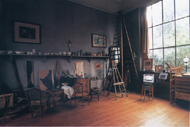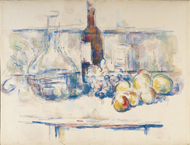|
This is the first exhibition to examine the watercolor still lifes of Paul Cézanne. One of the greatest artists of the later 19th century, Cézanne (1839–1906) paved the way for 20th-century painters such as Picasso. Among Cézanne's lesser-known masterpieces are his late still lifes in watercolor. Ranging from simple studies to complex compositions, they demonstrate a spontaneous, exuberant side of his art.
|
 |
|
Watercolor is a medium known for its luminous color as well as its difficulty. Still Life with Blue Pot, shown here, is one of Cézanne's late masterpieces in the medium. It shows an unusually complex technique. For the tapestry covering the table, Cézanne applied many layers of color, allowing each layer to dry before he applied the next. The napkin and pitcher in the center, by contrast, are formed from the blank white of the paper. This is a radical use of blank paper in a watercolor.
|
 |

 |
 |
Photograph of Cézanne's studio at Les Lauves, which has been preserved as he left it in 1906.
|
 |
 |
Cézanne painted watercolor still lifes throughout his career. But he made his largest, most complicated watercolor still lifes at the end of his career, between 1902 and 1906. During these years, Cézanne worked in his final studio at Les Lauves, near his native Aix-en-Provence. Today the studio is open as a museum and preserves a number of the objects that he painted in his still lifes.
|
 |
 |

 |
 |
Three Skulls, Paul Cézanne, 1902–1906
The Art Institute of Chicago, Mr. and Mrs. Lewis Larned Coburn Memorial Foundation
|
 |
Cézanne often depicted human skulls. In still lifes, skulls frequently symbolize the briefness of human existence.
These three skulls sit like apples on a table, casting a haunted stare at the viewer. Their undulating teeth, eye sockets, and nose openings echo the colorful swirls of the rug beneath them.
|
 |

 |
 |
The Green Pot, Paul Cézanne, 1885–1887
Musée du Louvre, Departement des Arts Graphiques. Fonds du Musée d'Orsay
|
 |
 |
|
|
 |
Cézanne derived his still life imagery from the earthy, homespun world of Aix-en-Provence, his hometown in the south of France. Many of the objects in his still lifes were made in Provence, such as terracotta pots, cognac bottles, and brilliant floral fabrics.
Here Cézanne focused on a single object—a humble pot made of green-glazed Provençal earthenware. This pot, like many of the objects Cézanne painted, has a personality of its own. With its outthrust belly and bent arm, it looks almost like a human model.
|
 |
 |

 |
 |
Still Life with Apples on a Sideboard, Paul Cézanne, 1900–1906
Dallas Museum of Art, The Wendy & Emery Reves Collection
|
 |
Cézanne's still lifes range from simple studies to complex compositions. Some of his still lifes were studio exercises done to practice his craft. Others were designed to be complete finished pictures.
Few of Cézanne's watercolor still lifes are as thoroughly painted as this one, at right. It contains objects that appear in several of his still lifes, including the blue pot that dominates the composition at the top of this page. Here the pot sits humbly beside a decorated pitcher at the center of the composition. This is among the fullest and richest of Cézanne's late watercolors.
|
 |

 |
 |
Still Life with Green Melon, Paul Cézanne, 1900–1906
Private collection
|
 |
 |
Cézanne painted three spectacular still lifes with watermelons. They show the artist's fascination with the fruit's shape, which changes depending on the viewpoint. Here Cézanne placed the stem end of a watermelon at the center of a cluster of objects. The kaleidoscopic forms and dynamic brushwork are typical of Cézanne's mature watercolor technique.
|
 |
 |

 |
 |
Still Life with Carafe, Bottle, and Fruit, Paul Cézanne, 1906
The Henry and Rose Pearlman Foundation, Inc.
|
 |
This still life showcases Cézanne's emphasis on the process of painting itself. Each object in the composition has a different ratio of watercolor to pencil. The glass has very little pencil or watercolor, while the wine bottle has a great deal of both. The carafe has more line than color. The silvery lines of the pencil show through the watercolor, complementing the delicate colored washes.
Traditional watercolorists first made a sketch in pencil, then fillled in the sketch with colored washes. Cézanne had a more open-ended working method. He made multiple marks in pencil and paint, switching back and forth between pencil and watercolor brush.
The exhibition is located at the Getty Center, Museum, West Pavilion, Plaza Level.
This exhibition is sponsored by 
|
 |






